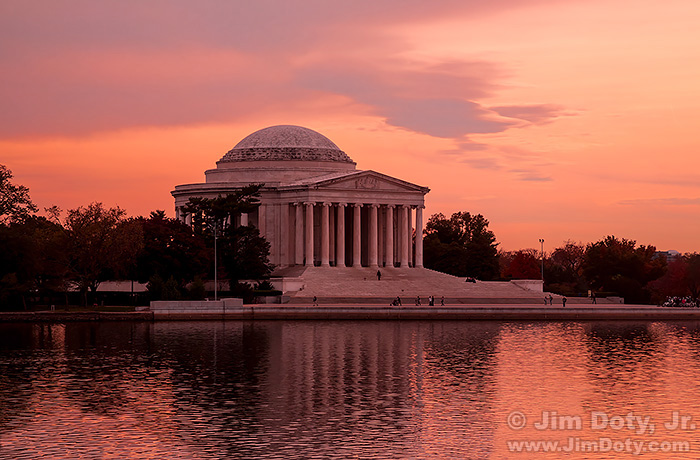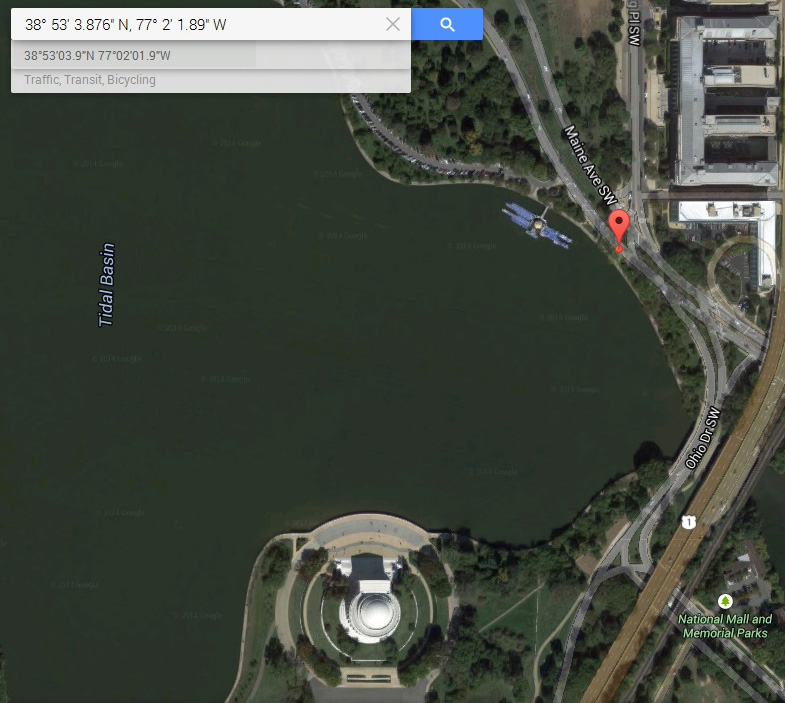I don’t usually recommend taking pictures from a moving car, but we were coming up to the Jefferson Memorial and I liked the light and the rippled reflection in the water. In the busy DC traffic, asking the driver to stop the car in the street was a recipe for disaster (and there was no place to pull over). I had to grab this shot on the fly which, from a fast moving car, is harder than you might think.
The problem was the motion of the car. If you are taking pictures from a moving car you need the same motion stopping shutter speed that you would use if you were standing still and photographing a moving car, and that varies with the speed of the car, the focal length of your lens, and the distance to the subject. I have a chart with motion stopping shutter speeds but we were fast approaching the memorial so there was no time to get out a chart.
I knew from past experience that I would need something in the neighborhood of 1/500 to 1/1000 second. My camera was in manual mode. With only seconds to get ready I rolled down the window, set the ISO to 800, spun the shutter speed dial to 1/1000 second, and turned the aperture dial to f/11 to get a good meter reading for lighter areas of the sky.
My next problem was all of the trees on Maine Ave SW. They were a blurred barrier between me and the Memorial. I needed a break between the trees. I looked ahead, picked my spot and clicked the shutter button. There was time for only one shot.
In a situation like this, the manual camera adjustments need to be make quickly, and almost without thinking. The more experience you have working in manual mode, the more quickly your fingers will adjust the camera settings, almost as if they have a mind of their own. It is like a trained concert pianist who sees a blizzard of notes and the fingers fly over the piano keys. Muscle memory is everything.
Thanks to the darker tones in this image, auto exposure in this situation would blow out the lighter areas of the sky, destroying the delicate colors. Manual exposure mode was the only way to be sure the colors in the sky would all be preserved.
The photo ended up being quite sharp, in fact I was pleasantly surprised since this kind of thing doesn’t always work out. With more time I would have gone with an aperture of f/8 and a shutter speed of 1/2000 second but I had mere seconds to grab my camera, make some quick settings and get the shot.
Roll down the car window so you can get the clearest possible shot. Car windows can degrade the image. Hold your camera back from the window so your camera doesn’t get buffeted about by whatever wind is rushing in the open window.
For the obvious reasons, all of the above assumes you are a passenger in the car.
Photo Data:  Canon 5D Mark III, Canon EF24-105mm f/4L IS USM lens at 100 mm. 1/1000 sec, f/11, ISO 800. GPS location: 38° 53′ 3.876″ N, 77° 2′ 1.89″ W.
Link
If your fingers don’t fly over your camera in the manual exposure mode, or if you don’t even use manual exposure mode, it is time to read Digital Photography Exposure for Dummies (which is one of the highest rated photography books at Amazon.com). Learn more here and order it at Amazon. Digital Photography Exposure for Dummies also has a chapter on using shutters speeds to creatively blur or freeze your subjects.


